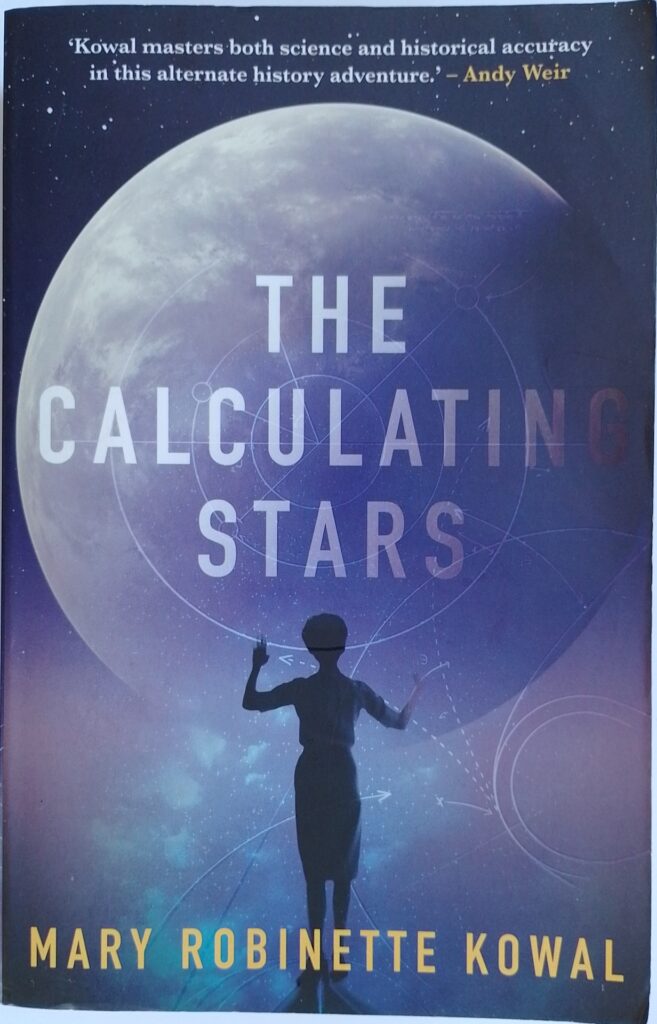First published 2018. Solaris paperback, 2019, pp 527, c.140,000 words (main text).
This is an alternate history set in the 1950s where the USA has just won the space race but then a large meteorite smashes into the sea just off the coast, utterly destroying Washington and much of the surrounding eastern seaboard, and triggering massive climate change that could be an extinction event for humanity. The main protagonist is Elma York, a ‘computer’, i.e. a person who did complicated mathematical calculations before the age of electronic computers, at NACA (the predecessor organisation of NASA.) The book Hidden Figures by Margot Lee Shetterly and the film of the same name where both released in 2016 just after Kowal finished this book, and that will have made many familiar with human, particularly women, computers working for NASA in the 1950s and 60s.
Elma York is also an expert pilot, having flown many missions as a WASP during the second world war. WASPs delivered aircraft and helped trained pilots at a time when women were not allowed combat roles. She was a maths prodigy, attending Stanford University as a young teenager, and that experience seems to have added to her fear of public speaking which manifests in extreme anxiety and vomiting. She is conscious of her parents speaking in her ear: her father saying “You can do this and I’ll be disappointed if you don’t” and her mother saying “What will people think?” Southern manners are important to her: she frequently smooths her skirt before meeting someone – a very 1950s gesture. Elma is married to Nathaniel, the chief engineer at NACA, at least after the meteorite strikes, and they have a very close and loving relationship which is beautifully drawn; the writer momentarily directly addresses the reader at a couple of points for emphasise.
But this is the 1950s. There is great fear of what the Russians might do, here in relation to the devastation caused by the meteorite in the USA which caused the loss of most of the central government. War mongers are stirring things. And most prominently, all types of prejudice are foreground: primarily, the roles of men and women, but also white and black. Elma is Jewish, which is an additional sensitivity for her but not otherwise an obvious disadvantage. These elements are very convincingly put together. A twenty-first century reader is continuously made angry by these perpetual barriers and yet somehow it isn’t overdone or stuffed excessively in one’s face. Elma herself doesn’t initially realise how she only sees the ‘white world’, and the black family that take her in are not always sensitive to her Jewishness. There are some delicately balanced scenes where women have to choose between throwing up their chances of becoming astronauts and outing the demeaning position they are placed in.
There are some obvious ‘bad guys’, notably the wonderfully drawn Stetson Parker. Like all the characters even Stetson has his extra dimensions. He can be utterly charming in public and he is a great pilot and trainer. He also has his troubles.
The science here is very strong, the physics seems real and the period jargon accurate. Kowal acknowledges help from a variety of experts. This is Andy Weir (The Martian) standard of hard SF, and one can’t say better than that. Weir is quoted on the cover and inside as commending the book.
Kowal’s writing is lucid, and the story bowls along in a very compelling way. I stumbled on a couple of Jewish words that I was unfamiliar with (‘mishegas’ [p46] and ‘tchotchkes’ [p49].) The characters spring to life, and while many are heroic, none are superheroes. There are some charming, very nicely done, sex scenes, told entirely from the woman’s point of view. They aren’t graphic but humorous, with lots of rocket metaphors. Some of the rituals of the Jewish faith were engagingly described – not something usually found in science fiction.
Kowal won both the Hugo Award for Best Novel and the Nebular Award for Best Novel in 2019 for this, and deservedly so. The book may be a little bit didactic with its constant 1950s sexism, but then that was probably the reality of the period. It will be interesting to see how it reads in twenty years’ time, but for now it is strongly recommended both as an excellent piece of SF and as a reminder that we live in at least slightly better days. This is the first book in a (currently) four book series. It stands up satisfactorily on its own, without an obvious cliff-hanger ending. The second was published almost simultaneously with this, and I hope to be reading it soon.
© William John Graham, March 2023

